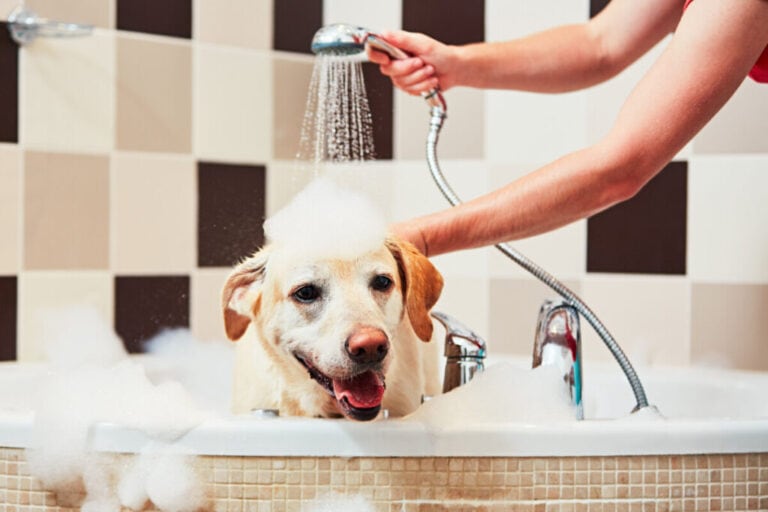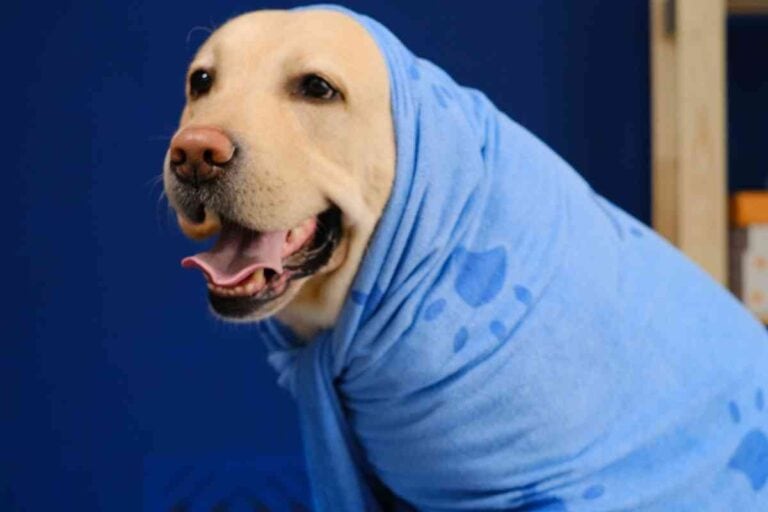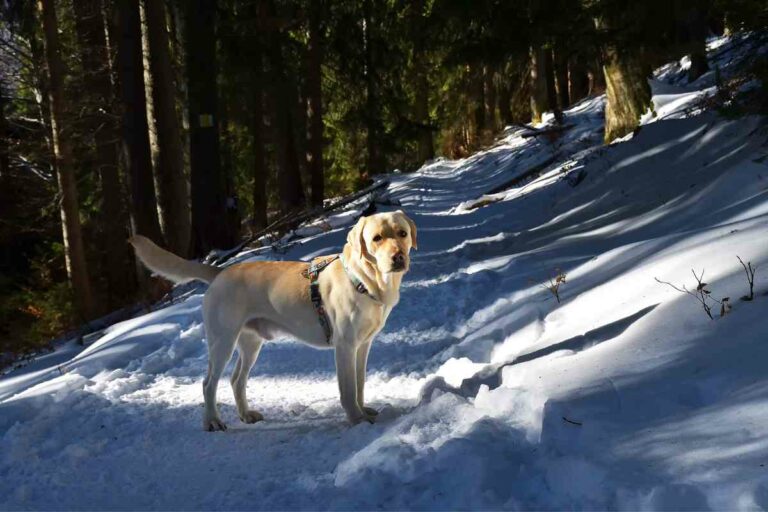Advanced Training Techniques for Labrador Retrievers: Tips and Strategies
Labs can do just about anything–good and bad! These advanced training techniques for Labrador Retrievers offer advanced training for taking your Lab to the next level and techniques for dealing with common Labrador problem behavior.
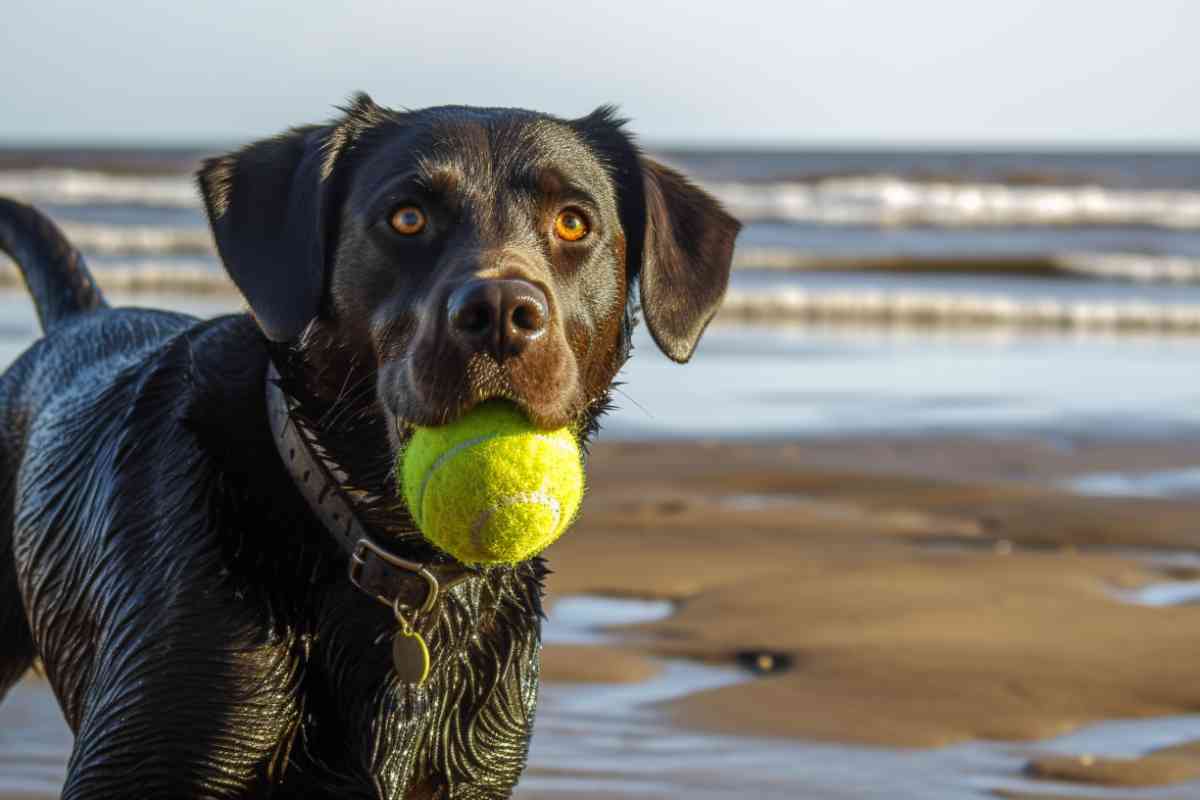
What are advanced training techniques for Labrador Retrievers?
Whether it’s competitive sports, where they can showcase their agility and discipline, hunting expeditions that tap into their natural retrieving instincts, or service work that leverages their loyalty and keen senses, Labradors excel when trained appropriately. Advanced training can assist with common problems in Labs like bolting and pulling, overexcitement, and counter surfing.
Whether you’re aiming to hone your Labrador’s skills for a competition, train them for specialized tasks, or simply curb unwanted behaviors, this comprehensive guide offers insights and strategies to elevate your Labrador’s training journey.
Advanced Training Techniques for Labrador Retrievers
Why Labs are Fun and Easy to Train and What They’re Best At:
Labradors are renowned for their obedient nature, making them one of the most sought-after breeds for families and individuals alike. Congratulations to those who’ve recently welcomed a new puppy, especially a lab puppy, into their homes!
One of the reasons labs are so popular is because of their innate desire to please their owners. This trait, combined with the right training methods, such as positive reinforcement training, makes labrador puppy training a relatively smooth process.
Adult dogs, both males and females, can be trained with ease, but starting with lab puppies can yield even better results. Labrador puppies are like sponges, eager to learn and adapt. With consistent training, you’ll often find them walking on a loose leash, showcasing their obedient nature. Breeders often emphasize the importance of early training, especially when it comes to lab puppy training. This ensures that as they grow, they retain the good habits instilled in them.
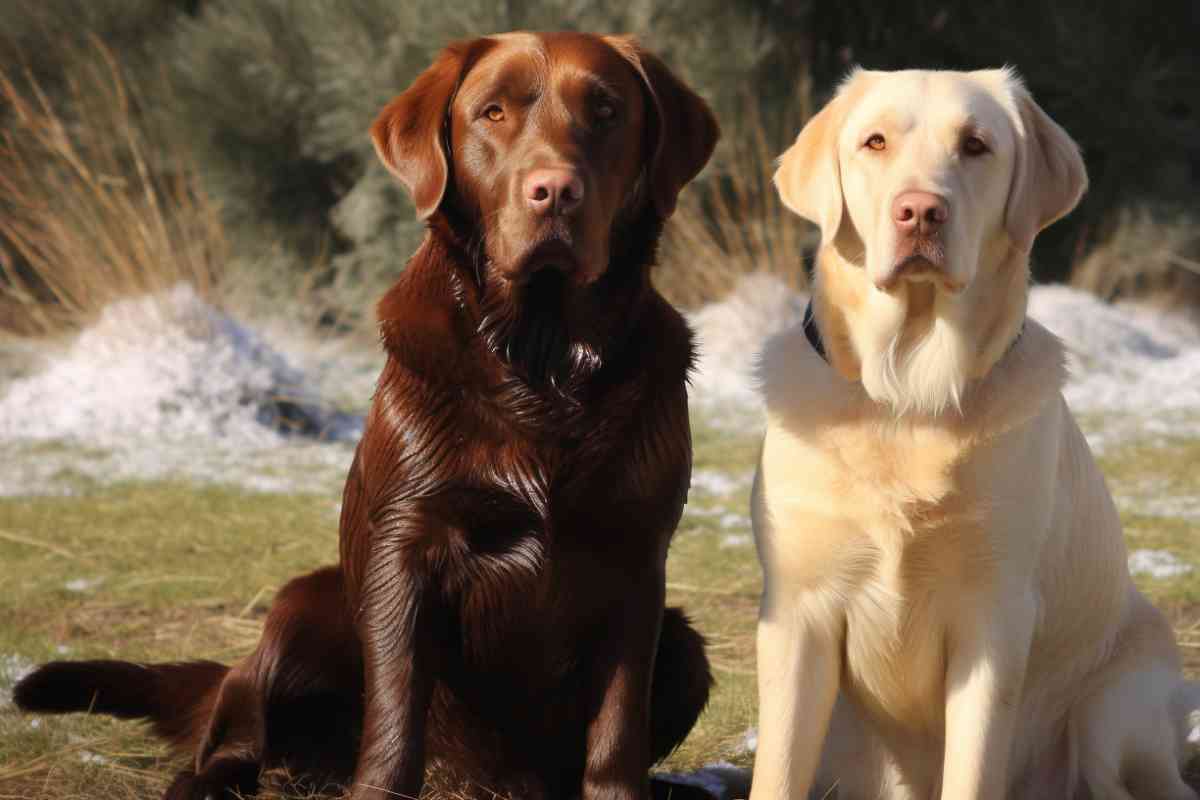
Training Your Labrador to Compete in Competitive Sports
Teaching Your Labrador to Dock Dive
Dock diving is an exhilarating sport where dogs leap off a dock to retrieve a toy floating in the water, competing for distance, height, or speed.
Labradors, with their love for water and natural retrieving instincts, are often excellent candidates for this sport.
1. Familiarize with Water
Before diving off docks, ensure your Labrador is comfortable with water. Start by introducing them to shallow water, allowing them to wade and play.
Gradually increase the water depth, ensuring they’re confident swimmers. Using a kiddie pool can be a great way to start this process.
2. Introduce the Dock
Once your Labrador is water-confident, introduce them to the dock.
Let them walk around, sniff, and explore. Initially, keep your sessions short to prevent overwhelming them. Use treats and praise to make the dock a positive environment.
3. Toy Motivation
Find a toy that your Labrador is particularly fond of, something they’d be willing to jump into the water for. It could be a favorite ball or a specially designed floating toy.
Play fetch games on land first, building their excitement and drive to retrieve the toy.
4. Start with Small Jumps
Don’t expect your Labrador to make massive leaps initially. Start at the edge of the dock, throwing the toy a short distance into the water and encouraging your dog to jump after it. Use enthusiastic verbal cues like “Go!” or “Jump!” to motivate them.
Celebrate every effort, even if they only step off the dock initially.
5. Increase Distance Gradually
As your Labrador gains confidence, increase the distance you throw the toy, encouraging longer and higher jumps.
Remember to keep the sessions fun and positive. If your dog seems hesitant or scared, take a step back and work on building their confidence again.
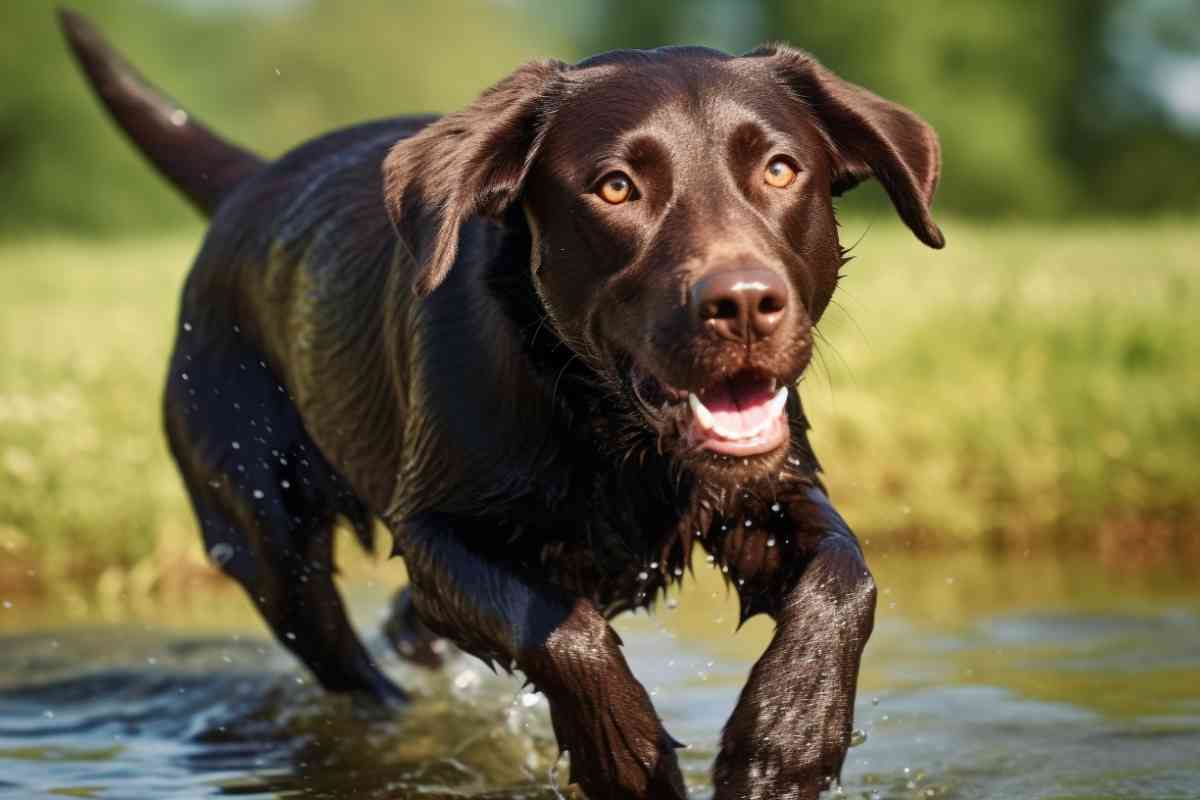
Training Your Labrador for AKC Rally: A Beginner’s Guide
AKC Rally is a dog sport that combines obedience and agility, where dogs and their handlers navigate a course with numbered signs indicating different exercises to perform.
Labradors, known for their intelligence and eagerness to please, can excel in this sport with the right training.
1. Understand the Basics of AKC Rally
Before diving into training, familiarize yourself with the rules and regulations of AKC Rally.
This will give you a clear understanding of what’s expected in the sport. Watch videos of competitions or attend local events to get a feel for how the sport is conducted.
2. Master Basic Obedience Commands
Before introducing Rally-specific exercises, ensure your Labrador has a strong foundation in basic obedience.
Commands like sit, stay, heel, and come are essential. These commands form the basis for more complex exercises in Rally.
3. Introduce Rally Signs and Exercises
Start by introducing one Rally sign at a time. Set up a training area where you can place the sign and practice the specific exercise with your Labrador. Use treats, toys, and praise as rewards for correctly executed exercises.
As your dog becomes proficient with one sign, introduce another, gradually building up the number of exercises your dog can perform.
4. Set Up Practice Courses
Once your Labrador is familiar with several Rally signs and exercises, set up a mini-course at home. This will simulate the actual Rally environment, helping your dog understand the flow of moving from one sign to the next.
Walk your dog through the course, guiding them through each exercise. Remember to reward and praise them for correctly following the course and executing the exercises.
5. Practice Regularly and Stay Positive
Consistency is key in Rally training. Set aside regular training sessions, but keep them short and fun to prevent your Labrador from becoming bored or overwhelmed. Always end on a positive note, celebrating even the small victories. If you encounter challenges, consider joining a local Rally training class or seeking advice from experienced Rally competitors.
Introducing Your Labrador to Canine Agility: A Comprehensive Guide
Canine agility is a fast-paced sport where dogs navigate through a timed obstacle course, showcasing their speed, agility, and obedience.
Labradors, with their energetic nature and keen intelligence, are well-suited for this sport.
1. Understand the Basics of Canine Agility
Before starting your agility journey, familiarize yourself with the sport’s fundamentals. This includes understanding the different obstacles like jumps, tunnels, weave poles, and more.
Watching videos of agility competitions or attending local events can provide valuable insights into how the sport operates.
2. Build a Strong Obedience Foundation
Agility requires a combination of speed and obedience. Ensure your Labrador has mastered basic commands like sit, stay, heel, and come.
This foundation will be crucial when guiding them through complex agility courses.
3. Introduce Agility Equipment Gradually
Start by introducing one piece of agility equipment at a time. For instance, you can begin with a tunnel. Encourage your Labrador to enter and exit the tunnel using treats or toys as motivation.
Once they’re comfortable with one obstacle, move on to the next. Remember to always make the experience positive and fun.
4. Set Up Mini Agility Courses
After your Labrador is familiar with individual agility obstacles, create a mini-course in your backyard or a spacious area. Guide your dog through the course, helping them navigate each obstacle in sequence. Use verbal cues and hand signals to direct them, rewarding successful navigation with treats and praise.
5. Join Agility Training Classes
Consider enrolling in a local agility training class. These classes offer structured training, access to full agility courses, and guidance from experienced trainers.
Participating in a class also provides your Labrador with the opportunity to train in a more distracting environment, simulating actual competition conditions.

Training Your Labrador for Competitive Obedience: A Step-by-Step Guide
Competitive obedience is a canine sport that showcases a dog’s training and discipline through a series of commands and exercises. Labradors can excel in this discipline with the right training approach.
1. Understand the Basics of Competitive Obedience
Before diving into training, familiarize yourself with the rules, exercises, and expectations of competitive obedience.
This will give you a clear understanding of what’s required in the sport. It’s beneficial to watch videos of competitions or attend local obedience trials to observe experienced handlers and their dogs in action.
2. Master Basic Obedience Commands
The foundation of competitive obedience lies in mastering basic commands. Ensure your Labrador is proficient in commands like sit, stay, heel, come, and down.
These commands form the basis for more complex exercises in competitive obedience.
3. Introduce Formal Heeling
In competitive obedience, the heel command is more structured than in everyday situations.
Practice heeling with your Labrador in a straight line, making turns, and halting, ensuring they maintain a consistent position by your side. Use treats and praise as positive reinforcement.
4. Practice Advanced Exercises
Once basic commands are solidified, introduce advanced exercises like retrieving, jumping, and scent discrimination.
For instance, in the retrieve exercise, your Labrador should pick up a designated object and return it to you. In scent discrimination, they should identify and retrieve an object with your scent among other objects.
5. Join Obedience Training Classes or Clubs
Consider enrolling in a local obedience training class or joining an obedience club. These platforms offer structured training, exposure to different exercises, and guidance from experienced trainers.
Participating in a class or club also provides your Labrador with the opportunity to train in an environment that simulates actual competition conditions.
Training Your Labrador to Hunt
Training Your Labrador for Waterfowl Hunting: A Five-Step Guide
Labradors are renowned for their hunting prowess, especially when it comes to waterfowl.
Their keen senses, combined with their love for water, make them ideal companions for duck hunting. Here’s a concise guide to train your Labrador for waterfowl hunting:
1. Start with Basic Obedience
Before diving into specific hunting skills, ensure your Labrador is well-versed in basic obedience commands like “sit,” “stay,” “come,” and “heel.”
A well-behaved dog that listens to commands is crucial in the field to ensure safety and success.
2. Introduce to Water Gradually
Labradors naturally love water, but it’s essential to introduce them to it in a positive manner. Start by playing fetch near a pond or lake.
Gradually encourage your dog to retrieve toys or training dummies from shallow water, progressing to deeper areas. This helps build confidence and reinforces their natural retrieving instincts.
3. Familiarize with Scents and Sounds
Expose your Labrador to the scents and sounds associated with duck hunting. This can include the smell of ducks, the sound of gunshot, and calls.
Begin with milder versions, like recorded gunshot sounds at a low volume, and gradually increase the intensity to acclimate your dog to the hunting environment.
4. Train with Retrieving Dummies
Invest in waterfowl retrieving dummies. These tools mimic the weight and feel of waterfowl, helping your Labrador practice fetching.
Start on land, and once your dog is confidently retrieving the dummy, move the exercise to water. Incorporate the use of scents on these dummies to make the training more realistic.
5. Practice in Real Hunting Situations
Once your Labrador is comfortable with the training exercises, it’s time to introduce them to real hunting scenarios.
Start with controlled environments, perhaps with other experienced hunting dogs. Over time, as your dog’s skills and confidence grow, you can venture into more complex hunting situations.
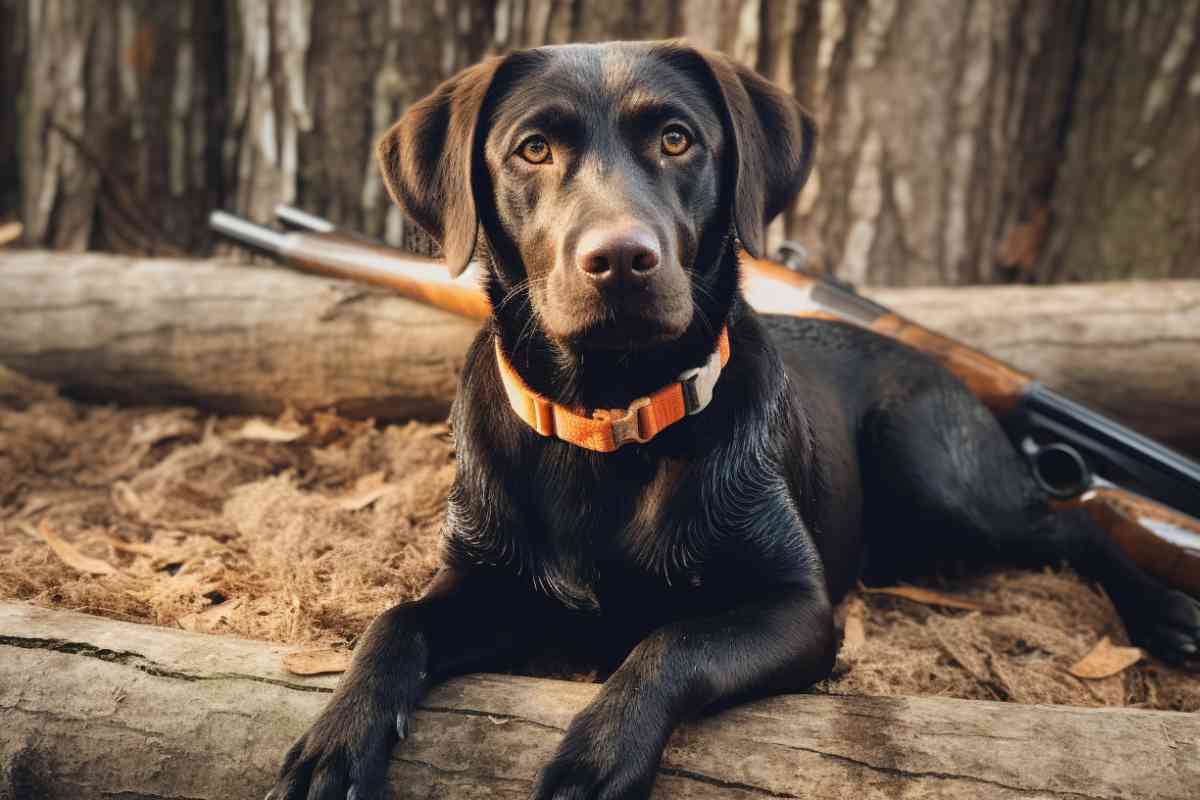
Training Your Labrador to Hunt Deer: A Comprehensive Guide
While Labradors are traditionally known for waterfowl hunting, their keen senses and adaptability make them suitable for deer hunting as well.
Training your Labrador to hunt deer requires a combination of their natural instincts and specialized training techniques.
1. Harness Natural Instincts
Labradors possess a strong prey drive and a keen sense of smell. Begin by harnessing these natural instincts.
Encourage your dog to track scents during your regular walks. You can do this by laying a scent trail using deer scent and rewarding your Labrador when they successfully track it.
2. Obedience and Control
Before introducing your Labrador to the hunting field, ensure they are well-trained in basic obedience commands like “sit,” “stay,” “come,” and “heel.
In the unpredictable environment of deer hunting, having a dog that listens to commands is crucial for safety and success.
3. Acclimatize to the Environment
Deer hunting often involves navigating through dense forests and rough terrains. Familiarize your Labrador with such environments.
Regularly take them to wooded areas, allowing them to explore and become comfortable in such settings. This also helps them get used to the scents and sounds of the forest.
4. Introduce to Deer Scent and Sounds
Gradually introduce your Labrador to the scent of deer. This can be achieved using deer scent products or by exposing them to areas frequented by deer.
Additionally, play recorded sounds of deer to acclimatize your dog to their calls. Over time, your Labrador will learn to associate these scents and sounds with hunting.
5. Practice with Realistic Scenarios
Once your Labrador is comfortable with the training exercises, simulate real hunting scenarios. This could involve tracking a scent trail you’ve laid out, or even joining experienced deer hunting dogs in the field.
These real-life experiences will sharpen your dog’s tracking skills and prepare them for actual hunts.
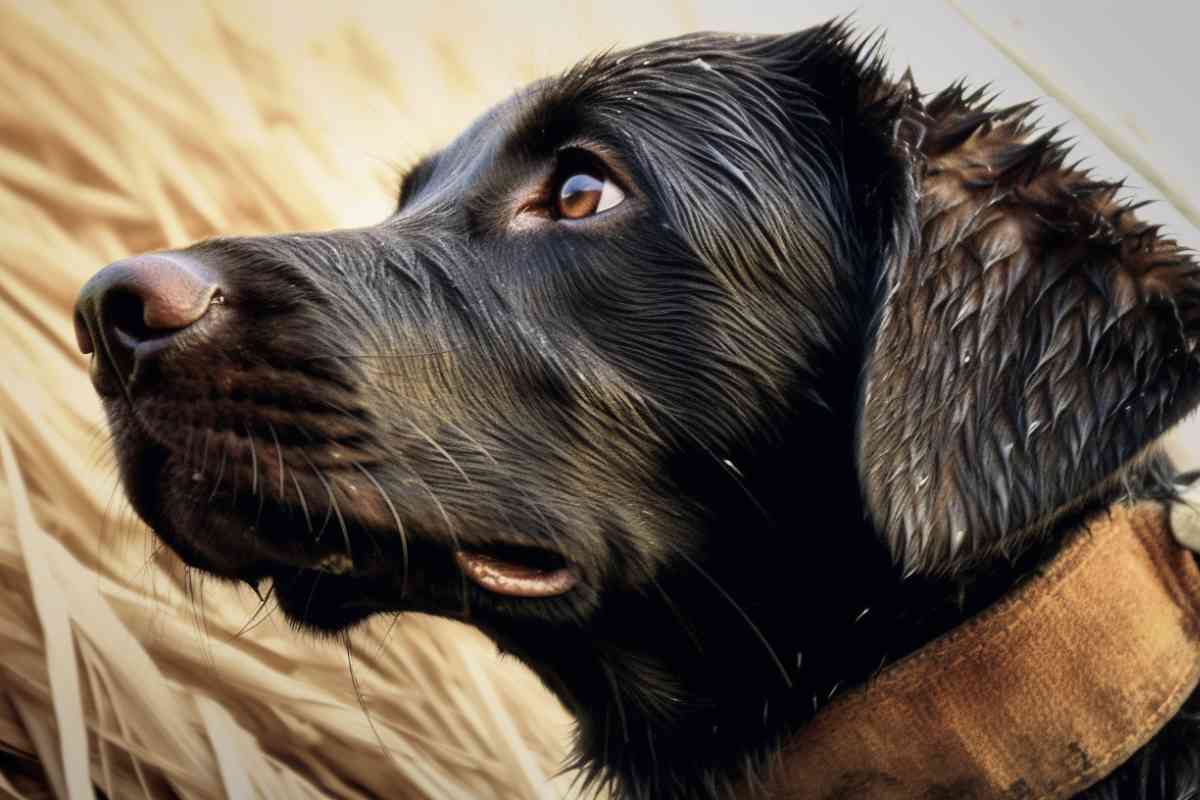
Training Your Labrador to Work
Training Your Labrador in Scent Work: A Five-Step Guide
Scent work is a fascinating and rewarding activity that taps into a dog’s natural instincts. For Labradors, with their keen sense of smell, it’s an excellent way to stimulate their minds and provide physical exercise.
1. Start with a Favorite Toy or Treat
Begin by selecting a toy or treat that your Labrador loves. This will serve as the initial scent target.
Let your dog play with it or eat it so they become familiar with the scent. This creates a positive association, making them more eager to find it during training sessions.
2. Set Up a Controlled Environment
Choose a quiet, distraction-free area for the initial training sessions. This could be a room in your house or a secluded spot in your yard.
Place the toy or treat in a visible location and encourage your Labrador to find it. Praise and reward them when they successfully locate the item.
3. Introduce Containers and Hide the Scent
Once your Labrador is consistently finding the visible item, it’s time to make it more challenging. Introduce containers like cardboard boxes.
Place the toy or treat in one of the containers and mix it up with empty ones. Encourage your dog to find the container with the item. Reward them generously when they correctly identify it.
4. Increase Complexity with Multiple Hides and Distractions
As your Labrador becomes more proficient, add more containers and introduce various distractions. This could include different scents or even placing the containers in different rooms or outdoor locations.
The goal is to gradually increase the difficulty, ensuring your dog relies more on their sense of smell and less on memory.
5. Introduce Specific Scents for Advanced Training
For those looking to participate in formal scent work competitions or activities, you can introduce specific scents like birch, anise, or clove.
These are commonly used in scent work trials. Start by letting your Labrador sniff the essential oil, then hide it using the same techniques as before. Over time, your dog will learn to identify and locate these specific scents among various distractions.
Training Your Labrador as a Therapy Dog: A Five-Step Guide
Therapy dogs provide comfort, affection, and support to individuals in hospitals, nursing homes, schools, and other settings.
Labradors, with their gentle nature and love for people, make excellent therapy dogs. Here’s a guide to train your Labrador for therapy work based on expert recommendations:
1. Understand the Role and Requirements
Before starting the training, it’s essential to understand the difference between therapy dogs, service dogs, and emotional support animals.
Therapy dogs are trained to provide comfort to various people, not just their handlers. They must be well-mannered, patient, and enjoy human interaction. Familiarize yourself with the specific requirements set by therapy dog organizations, as they often have guidelines regarding health, age, and temperament.
2. Focus on Basic Obedience
Your Labrador must master basic obedience commands such as sit, stay, come, heel, and down. They should also be well-behaved around other dogs and people.
Regular obedience classes can be beneficial, ensuring your dog is comfortable in various settings and can follow commands consistently.
3. Expose to Diverse Environments and Situations
Therapy dogs encounter various environments, from bustling hospitals to quiet reading rooms. Gradually expose your Labrador to different settings, noises, and people.
This includes elevators, wheelchairs, loud noises, and children. The goal is to ensure your dog remains calm and composed, regardless of the surroundings.
4. Enroll in a Therapy Dog Training Program
While basic obedience is crucial, therapy dog-specific training is equally important. Enroll your Labrador in a therapy dog training program, where they’ll learn skills tailored to therapeutic interactions.
This includes being gentle with patients, understanding when to approach or give space, and how to react to sudden movements or sounds.
5. Pass the Therapy Dog Evaluation
Once training is complete, your Labrador will need to pass an evaluation conducted by a recognized therapy dog organization.
This test assesses your dog’s behavior in typical therapy situations, ensuring they’re safe and effective in their role. After passing, you’ll receive certification, and your Labrador will officially be a therapy dog.

Training Your Labrador as a Service Dog: A Comprehensive Guide
Service dogs play a crucial role in assisting individuals with disabilities, providing support in daily tasks and enhancing their quality of life.
Labradors, known for their intelligence and gentle temperament, are often chosen for this role. However, training a Labrador as a service dog is a challenging endeavor that requires dedication, time, and the right resources.
1. Understand the Role and Commitment
Service dogs differ from therapy or emotional support animals. They are trained to perform specific tasks for individuals with disabilities, such as guiding the visually impaired, alerting the hearing-impaired, or assisting those with mobility challenges.
Training a Labrador to become a service dog is a long-term commitment, often taking several years. It’s essential to recognize that not every Labrador is suited for this role, as it requires specific temperaments and abilities.
2. Start with Basic Obedience and Socialization
Before diving into specialized training, your Labrador must master basic obedience commands like sit, stay, come, and heel.
Early socialization is also crucial. Expose your dog to various environments, people, and other animals to ensure they are adaptable and comfortable in different situations.
3. Specialized Task Training
Depending on the individual’s needs, service dogs undergo specialized training. This could involve pulling a wheelchair, retrieving items, alerting to specific sounds, or even detecting changes in an individual’s health condition.
For Labradors, their keen sense of smell and eagerness to please make them excellent candidates for many of these tasks. However, this phase of training is intricate and requires expert guidance.
4. Public Access Training
Service dogs must behave impeccably in public settings. This training ensures that the dog can handle distractions, remain calm in crowded places, and not react to provocations.
They should also be trained to work without receiving food or affection during their tasks, focusing solely on their handler’s needs.
5. Continuous Testing and Evaluation
Throughout the training process, and even after certification, service dogs undergo continuous evaluations. These assessments ensure that the dog is performing its tasks correctly and safely.
Regular check-ins and refresher courses might be necessary to ensure the dog maintains its training standards.
Advanced Training Techniques for Labrador Retriever Problem Behavior
While labs are known for their obedient nature, like all pups, they can develop bad habits and behavioral problems if not guided correctly. One common issue with labrador puppies and even adult dogs is chewing.
This behavior is especially prevalent when they’re teething. Chew toys can be a lifesaver during this phase, providing an appropriate outlet for their chewing tendencies.
Potty training and crate training are essential aspects of raising a well-behaved lab. These training methods, when implemented correctly, can prevent many bad behaviors.
For instance, crate training can help manage and reduce incidents of chewing, especially when you’re not around to supervise.
Here are some more common problems labs are prone to and what to do about it.
How to Train Your Labrador Not to Run Away
Train Your Dog Not to Run Away Using Clicker Training
1. Setting Up the Right Environment
Choose a comfortable, distraction-free setting like a fenced yard for effective training. It’s crucial to avoid high-distraction areas like dog parks.
Throughout the training, keep your dog leashed to ensure you have their full attention and control.
2. Utilizing a Long Line for Distance Training
Employ a long line, a leash that’s fifteen feet or more, to create a safe distance between you and your dog while retaining control.
This tool is invaluable for training commands that require your dog to be further away from you.
3. Preparing the Clicker (“Loading” the Clicker)
Before the actual training begins, familiarize your dog with the clicker sound by associating it with treats.
This “loading” process involves clicking the clicker and immediately giving your dog a treat. Once your dog equates the clicker sound with receiving a treat, you can proceed to the next step.
4. Associating Commands with Desired Behaviors
With your dog exploring the space at the end of the long line, call their name or use the “come” command.
When they exhibit the desired behavior, click the clicker instantly to mark that specific behavior. Follow the click with a treat to reinforce the association.
5. Refining and Reinforcing the Training
Practice the command with the clicker consistently over multiple sessions. As your dog becomes more reliable in responding, you can begin to replace the clicker with verbal praise.
However, if you ever use the clicker, always ensure it’s followed by a treat to maintain its effectiveness.
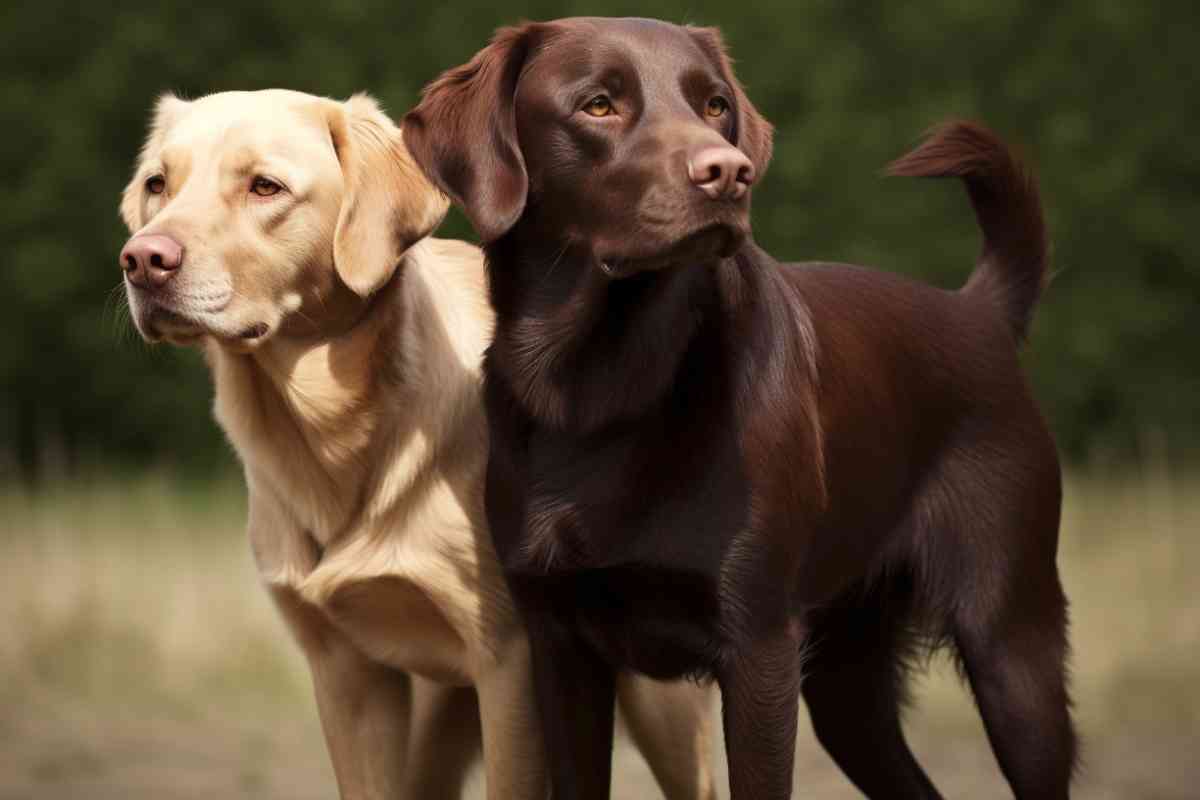
Training Your Labrador Not to Bolt Out of the Door
1. Recognizing the Importance of Door Manners and Choosing a Permission Word
Understanding door manners is crucial for dogs prone to escaping and exploring. The goal is to ensure your Labrador exits only when given permission. A unique word, like “exit,” can serve as this permission cue.
It’s vital for all family members to consistently use this word, helping your dog associate it with the act of leaving through a doorway.
2. Introducing Basic Door Manners with Tethering and Treats
Start by tethering your dog to prevent impulsive exits. As you slightly open the door, observe your dog’s reaction.
If he approaches, close it gently. This process should be repeated until your dog learns that approaching the door isn’t beneficial. When he remains in place, reward him.
3. Instilling Automatic Behaviors: Sit or Lay Down
Encourage your dog to either sit or lay down every time the door opens. This behavior should become automatic over time, without needing a specific command. Consistent practice will help ensure your dog adopts this behavior whenever the door is opened.
4. Gradual Door Opening and Introducing the “Exit” Command
Progressively open the door wider during training sessions, rewarding your dog for staying seated or laying down. Once you can fully open the door with your dog remaining calm, introduce the “exit” command.
If he stays seated or lies down, use the command and guide him through the doorway.
5. Advanced Training: Distractions, Different Doorways, and Transitioning Away from Tethers
Introduce distractions by placing interesting items outside the doorway, rewarding your dog for staying put. Practice the training with various doorways in your home and car.
As your dog becomes more reliable, transition from a tether to a lightweight rope, and eventually, no leash at all. Always ensure safety precautions are in place.
Note: Continuous reinforcement is essential to maintain this behavior throughout your dog’s life. Even with diligent training, occasional mistakes can happen.
Always prioritize your dog’s safety, ensuring they don’t have opportunities to make dangerous mistakes, such as running into traffic.
Training an Anxious Labrador
Training a Labrador with Anxiety
Labradors, like all dogs, can sometimes exhibit signs of anxiety or fear. Whether it’s due to past trauma, lack of early socialization, or genetic factors, it’s essential to approach training with patience and understanding.
1. Recognize the Signs of Anxiety
Before implementing any training strategies, it’s crucial to identify the signs of anxiety in your Labrador.
These can include excessive barking, trembling, avoidance, hiding, or even aggressive behavior. Understanding these signs will help you gauge your dog’s comfort level and adjust your training approach accordingly.
2. Create a Safe Space
Every anxious Labrador should have a safe, quiet space where they can retreat and feel secure. This could be a specific room, a crate, or a quiet corner.
Fill this space with their favorite toys, bedding, and other comfort items. Ensure that this area remains a positive, pressure-free zone where your dog can relax.
3. Use Positive Reinforcement
Always use positive reinforcement techniques when training an anxious Labrador. This means rewarding desired behaviors with treats, praise, or play.
Avoid punishment, as it can exacerbate anxiety and fear. Instead, focus on building trust and reinforcing positive behaviors.
4. Gradual Desensitization
For Labradors with specific fears (like loud noises or new people), gradual desensitization can be effective.
This involves exposing your dog to the fear-inducing stimulus at a very low intensity and gradually increasing the intensity over time. For example, if your Labrador is afraid of loud noises, you might start by playing a recording of the noise at a low volume, rewarding your dog for staying calm, and gradually increasing the volume over several sessions.
5. Seek Professional Help
If your Labrador’s anxiety is severe or if you’re unsure about the best training approach, consider seeking help from a professional dog trainer or behaviorist.
They can provide tailored strategies and support to help your Labrador overcome their anxiety.
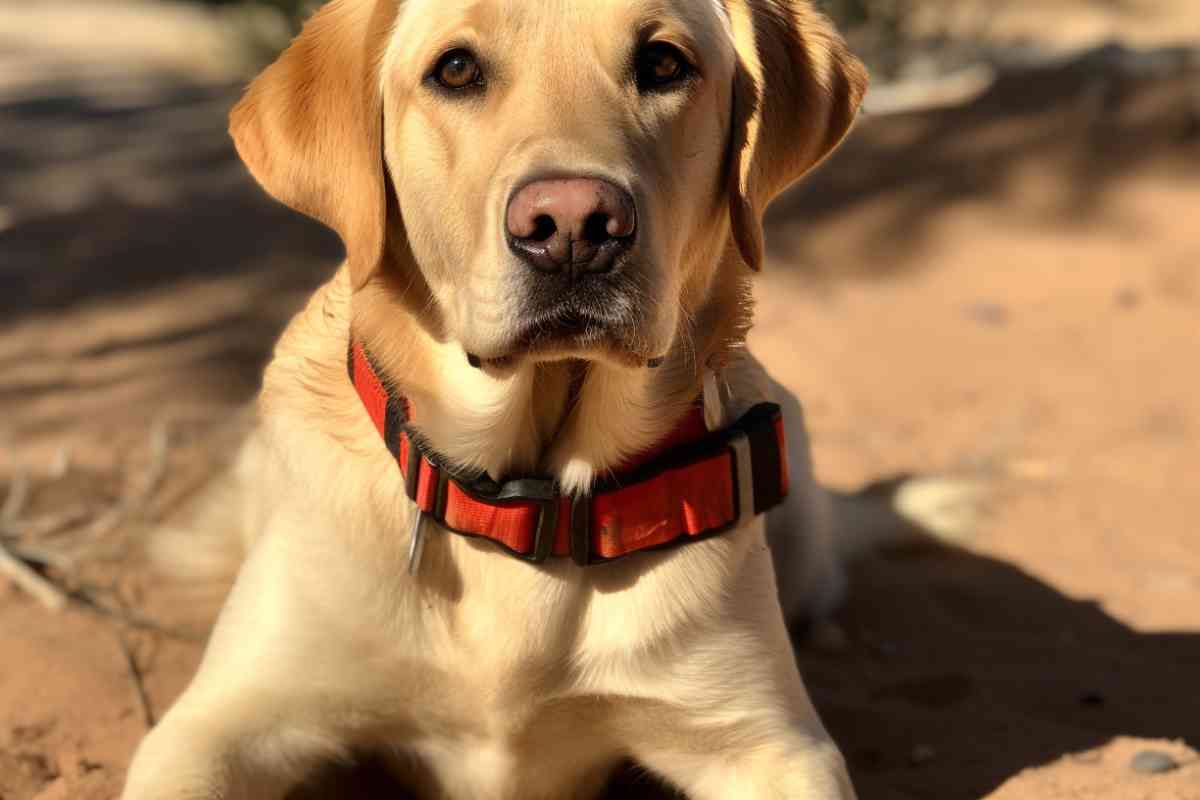
Training a Labrador with Separation Anxiety
Separation anxiety is a common challenge faced by many Labradors. Recognizing and addressing this issue is crucial for the well-being of your furry friend.
1. Recognize and Understand the Symptoms
Before implementing any training, it’s vital to identify the signs of separation anxiety.
These can include excessive barking, destructive behaviors, accidents in the house, pacing, or attempting to escape confined areas. Understanding these signs will help tailor your approach.
2. Gradual Desensitization and Routine
Begin by leaving your Labrador alone for short durations, gradually extending the time as they become more comfortable.
Consistency is key; maintaining a regular daily schedule for activities like meals, walks, and playtime can provide a sense of predictability, reducing potential anxiety triggers.
3. Create Calm Departures and Safe Spaces
Avoid dramatic goodbyes. Instead, keep departures and returns low-key to prevent heightening anxiety. Additionally, designate a comfortable space for your Labrador, equipped with their favorite toys or bedding.
This familiar environment can serve as a sanctuary during your absence.
4. Engage Their Mind and Offer Distractions
Before leaving, provide your Labrador with mentally stimulating toys, such as puzzle toys or those filled with treats.
These distractions can divert their attention from your absence, reducing feelings of loneliness and anxiety.
5. Seek Professional Guidance and Consider Medication
If your Labrador’s anxiety remains high despite your efforts, consult with a professional dog trainer or veterinary behaviorist.
They can offer specialized strategies tailored to your dog’s needs. In extreme cases, with the recommendation of a vet, medication might be considered to alleviate severe symptoms, always in conjunction with behavioral strategies.
Training Your Labrador to Behave Around Food and Chewing
How to Train Your Lab Not to Chew
1. Understand the Why Behind the Chew
Chewing is a natural behavior for dogs. Puppies often chew as a way of exploring their environment and due to the discomfort of teething.
On the other hand, adult dogs might resort to chewing as a coping mechanism for stress, boredom, or other underlying issues. It’s essential to remember that when dogs chew, it’s not out of malice or spite.
By understanding the root cause of the behavior, you can address it more effectively.
2. Dog-Proof Your Home
One of the most effective ways to prevent unwanted chewing is to make sure that tempting items are out of your dog’s reach.
This includes shoes, books, remote controls, and other household items that might be mistaken for toys.
By creating an environment where potential chew targets are minimized, you’re setting your Lab up for success and reducing the chances of unwanted incidents.
3. Provide Appropriate Chew Alternatives
Dogs have a natural inclination to chew, so it’s crucial to provide them with appropriate outlets for this behavior. Offer your Lab toys that are distinct from everyday household items.
This clear distinction helps them understand what’s acceptable to chew on and what’s not. Additionally, rotating these toys can keep their interest piqued.
Puzzle toys, which can be filled with treats or kibble, are especially effective as they engage your dog mentally as well as physically.
4. Engage Them Physically and Mentally
A well-exercised dog is less likely to engage in destructive behaviors. Ensure your Lab gets a good mix of physical exercise, like walks or play sessions, and mental stimulation, such as training exercises or puzzle toys.
Tailor these activities to their age, health, and breed characteristics. Remember, a tired dog is often a well-behaved dog, so keeping them engaged can go a long way in curbing unwanted chewing.
5. Positive Reinforcement Over Punishment
When training your Lab, it’s essential to focus on positive reinforcement rather than punishment. If your dog chews something they shouldn’t, calmly redirect them to an appropriate toy and reward them when they make the right choice.
Praise, treats, and affection are powerful motivators for dogs. On the other hand, scolding or punishing can lead to confusion and further behavioral issues. Building a trusting and understanding relationship with your Lab is the foundation for a harmonious coexistence.

Training Your Labrador to Overcome Food Possessiveness: A Five-Step Guide
Food possessiveness, also known as food guarding, is a natural instinct for many dogs, including Labradors. However, with consistent training, you can help your Labrador overcome this behavior, ensuring a safer and more harmonious environment.
1. Recognize the Signs of Food Guarding
Before implementing any training, it’s essential to identify the signs of food possessiveness. These can include growling, snapping, or even biting when someone approaches their food.
Your Labrador might also eat faster when someone is near or position their body to shield their food. Recognizing these behaviors is the first step in addressing the issue.
2. Desensitize and Associate with Positivity
Begin by standing at a distance from your Labrador while they eat, far enough that they don’t display any guarding behavior.
Toss a delicious treat into their bowl as you walk by. Over time, this will create a positive association: the approach of someone means even tastier food is coming.
Gradually decrease the distance as your Labrador becomes more comfortable, always ensuring they associate your approach with positive outcomes.
3. Implement Hand-Feeding
Hand-feeding can be a powerful method to reduce food possessiveness. Start by feeding your Labrador some of their meals directly from your hand.
This practice not only reduces guarding tendencies but also strengthens the bond between you and your dog, as they begin to see you as the provider of their food.
4. Teach the “Leave It” Command
Training your Labrador to understand and obey the “leave it” command can be invaluable. Start with a treat in both hands.
Open one hand and give the “leave it” command. If your Labrador tries to take the treat, close your hand. When they pull away, reward them with the treat from the other hand.
This teaches them that obeying the command leads to a reward.
5. Always Supervise and Ensure Safety
While training is underway, always supervise meal times, especially if children are present.
Children might not recognize the signs of food guarding and could inadvertently provoke a reaction. Until you’re confident that your Labrador’s food possessiveness has been addressed, maintain a safe environment during feeding.
Training Your Labrador to Avoid Counter Surfing
Labradors, with their curious nature and love for food, can sometimes develop the habit of counter surfing. This behavior not only leads to stolen food but can also pose risks if they ingest something harmful.
1. Maintain a Clean Counter
The first step in preventing counter surfing is to remove the temptation. Ensure that food items, especially those with strong aromas, are stored away and not left on countertops.
By keeping counters free of food, you reduce the chances of your Labrador being lured by the scent or sight of a potential treat.
2. Use Deterrents to Establish Boundaries
Consider using safe deterrents to make countertops less appealing. These can include double-sided tape, which dogs find uncomfortable to walk on, or commercial pet deterrent mats.
Over time, these deterrents can create a mental boundary for your Labrador, signaling that counters are off-limits.
3. Teach the “Off” Command
Training your Labrador to understand the “off” command can be invaluable. Start by placing a treat on a low table.
When your Labrador approaches, firmly say “off.” If they back away, reward them with a treat from your hand (not the one on the table). This reinforces the idea that obeying the command leads to a reward, while counter surfing does not.
4. Supervise and Redirect
Always supervise your Labrador in areas where counter surfing is possible. If you catch them in the act or even showing interest in the counter, redirect their attention.
This can be done by calling their name, using a toy, or giving them a command they know. Consistent redirection will teach them that there are better, more rewarding activities than counter surfing.
5. Provide Adequate Mental and Physical Stimulation
Often, dogs resort to behaviors like counter surfing out of boredom. Ensure your Labrador receives enough exercise and mental stimulation daily. Engage them in play sessions, walks, or training exercises.
Puzzle toys can also be a great way to keep them mentally engaged. A well-exercised and mentally stimulated Labrador is less likely to seek entertainment on countertops.
How to Train an Overexcited Labrador
Training Your Labrador Not to Jump Up: A Five-Step Guide
Labradors are known for their enthusiastic nature, and sometimes this enthusiasm translates into jumping up on people.
While it might seem endearing, especially when they’re puppies, it can become problematic as they grow.
1. Ignore the Jumping
When your Labrador jumps up, turn your back and avoid giving them any attention. This includes verbal reprimands.
Dogs often jump up because they’re seeking attention, and even negative attention can reinforce the behavior. By ignoring them, you’re teaching your Labrador that jumping up doesn’t get the desired response.
2. Reward Four-on-the-Floor
Encourage and reward your Labrador when all four paws are on the ground. This can be done with treats, praise, or petting. Over time, your Labrador will learn that keeping all feet on the floor leads to positive attention and rewards.
3. Teach the “Sit” Command
A sitting dog can’t jump up. Train your Labrador to sit on command. When they approach you or a visitor, ask them to sit. Reward them for obeying.
This not only prevents jumping but also provides them with an alternative behavior that’s positive and controlled.
4. Use Leash and Step Technique
When expecting visitors or in situations where jumping might occur, keep your Labrador on a leash. If they attempt to jump up, step on the leash, preventing them from getting their front paws off the ground.
This technique, combined with the “sit” command, can be very effective in controlling unwanted jumps.
5. Consistency is Key
Ensure that everyone in the household, as well as visitors, are on the same page regarding the no-jumping rule.
It’s essential that your Labrador receives consistent feedback. If some people allow jumping while others don’t, it can confuse your dog and make the training process longer.
Training Your Labrador Not to Pull on the Leash: A Step-by-Step Guide
Walking with your Labrador should be a pleasant experience for both of you. However, if your dog constantly pulls on the leash, it can turn your peaceful walk into a tug-of-war.
1. Choose the Right Equipment
Start with a well-fitted collar or harness. Some harnesses are designed specifically to discourage pulling by redirecting your dog’s movement.
Ensure that whatever you choose is comfortable for your Labrador and doesn’t cause any strain or discomfort.
2. Begin in a Distraction-Free Environment
Before heading out, start your training indoors or in a quiet garden where there are fewer distractions.
This allows your Labrador to focus on you and the training exercises without getting overly excited or distracted.
3. Use the ‘Stop-Start’ Technique
Every time your Labrador starts to pull, stop walking. Stand still and wait for them to return to your side or for the leash to slacken.
Only when the leash is slack should you start walking again. This teaches your dog that pulling gets them nowhere, and in fact, it halts their progress.
4. Introduce Temptations and Distractions Gradually
Place a toy or treat on the ground and walk your Labrador towards it. If they pull, use the ‘Stop-Start’ technique.
This exercise helps your dog understand that even when there’s something exciting ahead, pulling won’t get them there any faster. In fact, it will slow things down.
5. Reward Good Behavior
Always carry treats with you during your walks. Whenever your Labrador walks beside you without pulling, reward them with a treat and praise.
Positive reinforcement will encourage them to continue walking nicely without pulling on the leash.
Conclusion
Whether it’s excelling in competitive arenas, assisting in hunting expeditions, serving with dedication in specialized roles, or overcoming behavioral hurdles, Labradors continually prove their mettle.
However, the key to unlocking their full potential lies in understanding their unique needs and employing advanced training techniques. As we’ve explored in this article, with the right approach and dedication, a Labrador can be molded into a champion, a helper, or simply the best companion one could ask for.
As you embark on or continue your training journey with your Labrador, remember that patience, consistency, and positive reinforcement are your best allies. With these tools in hand, the sky’s the limit for what you and your Labrador can achieve together.

